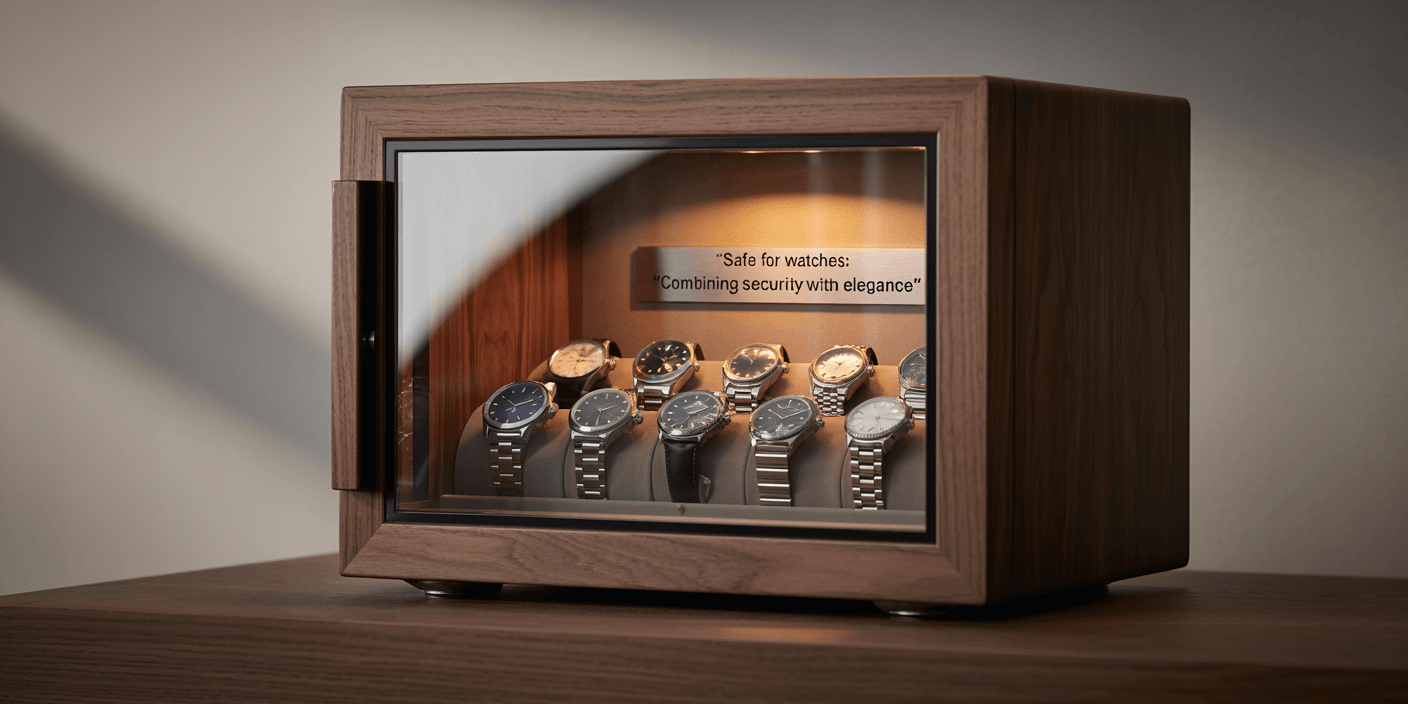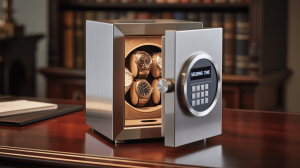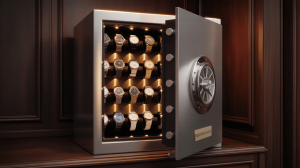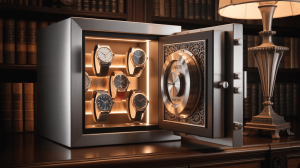How to Choose the Right Safe for Watches: A Comprehensive Guide. But here’s the kicker… Selecting the perfect watch safe means balancing security, climate control, and style—so your collection remains protected and on display.
1. Assess Your Security Needs
Determine your risk level by reviewing local crime statistics and home‑security measures. Opt for safes with UL RSC or ETL burglary ratings to guarantee at least five minutes of forced‑entry resistance. Choose lock types—mechanical dials never fail without power; electronic keypads enable multiple user codes and time‑delay features; biometric scanners offer one‑touch access. Plan your anchoring approach: bolt to floor joists for maximum theft deterrence or mount within furniture for stealth.
| Certification | Type | Resistance Time |
|---|---|---|
| UL RSC | Burglary rating | ≥ 5 minutes |
| ETL Burglary | Equivalent standard | Verified strength |
2. Determine Fire Protection Requirements
Watches suffer at temperatures above 350 °F. Seek UL 72 Class 350 ratings—30 minutes at 1,200 °F or longer for greater safety. Fireboard interiors (gypsum or ceramic composite) block heat transfer, while intumescent gaskets expand to seal out smoke. Weigh fire duration against safe size; higher ratings often add bulk.
3. Measure Capacity and Future Growth
Inventory your current watches, strap collection, tools, and paperwork. Estimate pillow height (~1.5–2 inches) then add clearance. Allow 20–30% extra space for new acquisitions. Modular foam trays and removable inserts let you reconfigure compartments as your collection evolves.
4. Select Exterior Materials and Aesthetics
Your safe’s shell impacts both security and design. 12–14 gauge steel provides robust protection; aluminum alloys reduce weight; powder‑coat finishes resist corrosion. For luxury décor, choose wood veneer panels or leather wraps in custom tones. Inspect weld quality—seamless, tamper‑proof welds eliminate weak points.
| Material | Durability | Visual Style |
|---|---|---|
| Steel (12 ga) | High forced‑entry resistance | Matte or gloss finishes |
| Aluminum Alloy | Moderate strength | Brushed metallic look |
| Wood Veneer | Decorative appeal | Custom décor match |
5. Choose Your Lock Mechanism
Mechanical dials are battery‑free and reliable but slower. Electronic keypads support multiple codes, time delays, and audit logs. Biometric scanners offer instant entry via fingerprint, requiring occasional re‑enrollment. Dual‑lock designs combine two methods—such as keypad plus key—for layered security tailored to your lifestyle.
6. Evaluate Interior Organization
A well‑organized interior prevents damage and simplifies rotation. Use foam or velvet‑lined pillows customized to case diameters. Adjustable trays let you fit larger or smaller watches. Hidden pockets beneath trays store straps, spring bars, and tools out of sight yet within reach.
7. Integrate Watch Winder Functionality
Automatic watches demand movement. Opt for winders with customizable turns‑per‑day (TPD) and directional settings (CW, CCW, bi‑directional). Look for ultra‑quiet motors (< 25 dB) to maintain home tranquility. Removable winder modules convert bays to static storage when winding isn’t needed.
| Winder Feature | Specification | Benefit |
|---|---|---|
| Adjustable TPD | 650–2,000 turns/day | Matches manufacturer guidelines |
| Direction Control | CW, CCW, bi‑directional | Prevents over‑winding |
| Noise Level | Under 25 dB | Silent home or office use |
8. Ensure Climate and Humidity Control
Humidity degrades leather straps and metal movements. Select safes with IP54‑rated seals to block dust and splashes. Install desiccant packs or silica gel chambers to maintain RH below 50%. Premium options provide digital hygrometers for real‑time monitoring and active dehumidification modules for precise control.
9. Plan for Ease of Access and Emergency Override
Convenience matters. Electronic keypads and biometric scanners grant fast entry; time‑delay settings deter forced attempts. Always include backup mechanical keys or override dials hidden behind discreet panels to ensure access if electronics fail or codes are forgotten.
10. Consider Noise and Vibration Levels
Excessive noise from winders or slamming doors disrupts calm spaces. Seek safes with vibration‑dampened motor mounts and soft‑close hinges. Motors rated under 25 dB run whisper‑quiet. Testing real‑world feedback confirms suitability for bedrooms or home offices.
| Noise Feature | Mechanism | Impact |
|---|---|---|
| Dampened Mounts | Rubber isolators | Reduces motor vibration noise |
| Soft‑Close Hinges | Hydraulic closure | Eliminates door slamming |
| Quiet Motors | Precision engineering | Maintains < 25 dB operation |
11. Explore Smart Connectivity Features
Modern safes connect via Bluetooth or Wi‑Fi—sending tamper, door‑open, and low‑battery alerts to your smartphone. Apps allow remote lock/unlock, TPD adjustments, and audit-log reviews. These features provide extra security when you’re away from home.
12. Review Power and Backup Strategies
Electronic locks and winders need reliable power. Choose safes offering both AC adapter and rechargeable battery pack support. Low‑battery alerts—via LEDs or app—prevent sudden shutdowns. Always keep a hidden manual override key or code for emergencies.
| Power Option | Backup Method | Maintenance |
|---|---|---|
| AC Adapter | N/A | Check connections monthly |
| Rechargeable Pack | Manual override key | Recharge every 6–12 months |
| USB‑C Charging | Hidden override PIN | Inspect cable quarterly |
13. Match Décor and Style
Your safe needn’t clash with interiors. Matte black and satin white suit modern spaces; wood veneers and leather wraps blend with luxury décor. Slim profiles slip into closets or cabinets. Custom color matching or engraving personalizes your safe as both security device and design feature.
14. Budgeting and Value Considerations
Safes range from entry-level ($100–$300) offering basic steel shells and key locks, to mid-range ($300–$700) with fire ratings and electronic keypads, to premium ($700+) featuring biometrics, smart apps, and luxury finishes. Prioritize essential certifications and interior needs before investing in optional extras.
15. Verify Warranty and Customer Support
A robust warranty—2–5 years covering structure and electronics—reflects manufacturer confidence. Onsite service options and spare‑part availability ease repairs. Review customer feedback on support responsiveness and service quality before purchase.
Conclusion
Selecting the right safe for your watches means synthesizing security ratings, fire protection, capacity, organization, climate control, access methods, smart features, style, budget, and support. Ready for the good part? Use this comprehensive guide to compare certified models and choose a stylish safe that secures and showcases your collection flawlessly.
FAQ
Q1: What burglary rating should I choose?
Aim for UL RSC or ETL certification to guarantee forced‑entry resistance.
Q2: How often replace desiccant packs?
Every 6–12 months, depending on local humidity.
Q3: Are biometric locks reliable long term?
Premium modules include encrypted templates and backup options.
Q4: Do smart features require subscription fees?
Basic app controls are free; advanced monitoring services may incur fees.
Q5: Is professional installation necessary?
DIY anchoring works—ensure you bolt to studs or concrete per guidelines.







